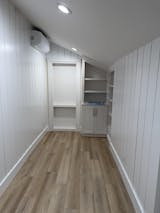The Concept
Unlock the potential of your living space with our innovative concept, the Mirror Bookcase Door. Unlike conventional doors that merely divide rooms, our Mirror Bookcase Door revolutionizes your interior design by transforming wasted space into multifunctional brilliance.
Each Mirror Bookcase Door boasts a full-length safety-backed mirror glass on the front, providing both practicality and a touch of sophistication. Meanwhile, the back features a standard bookcase design, offering ample storage space for your essentials.
Customization is key with our Mirror Bookcase Doors. Tailor your door to suit your preferences by selecting from a range of trim packages or adding cabinet doors, allowing you to create a personalized piece that perfectly complements your space. Elevate your home decor with our customizable Mirror Bookcase Doors today.


































